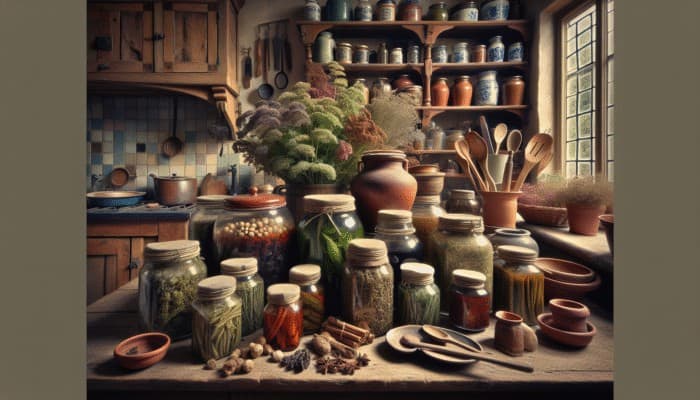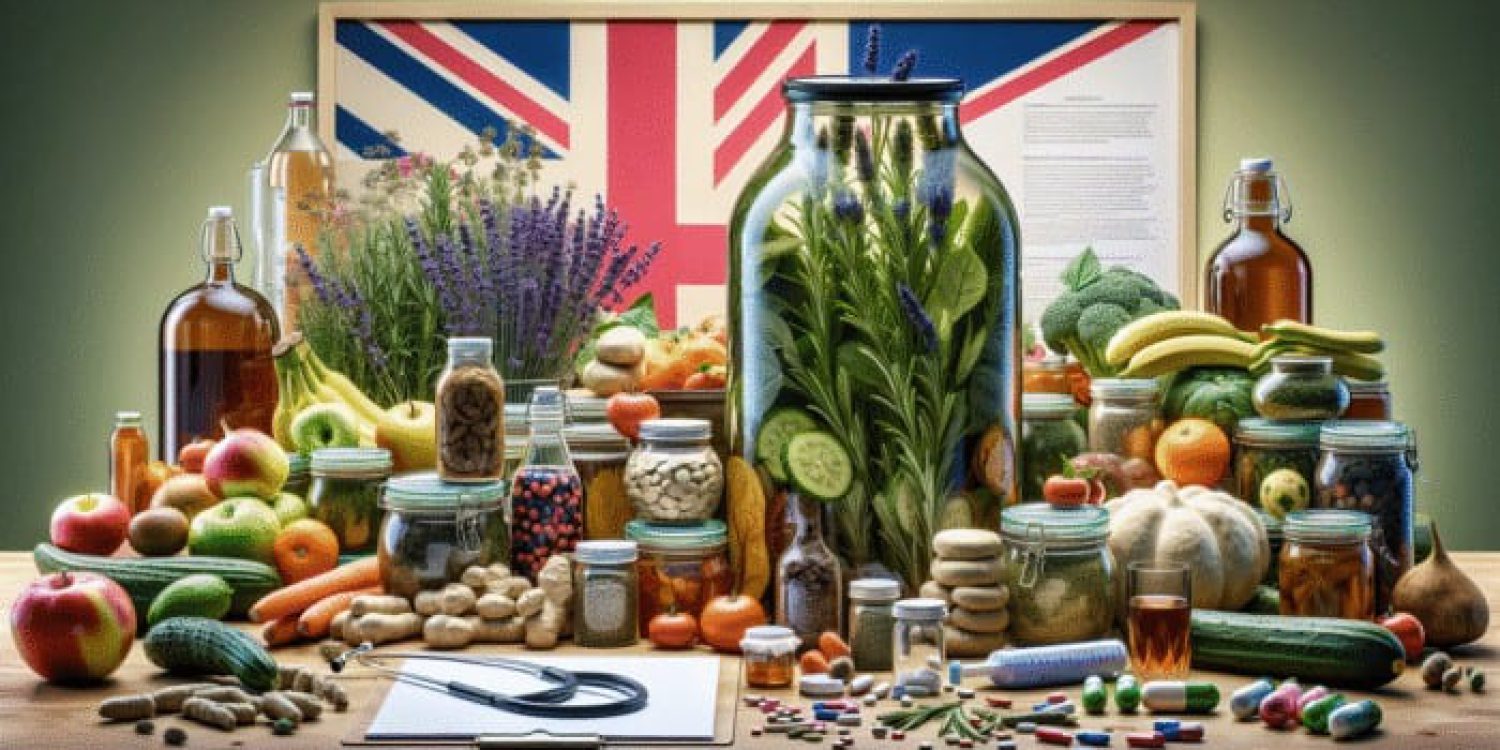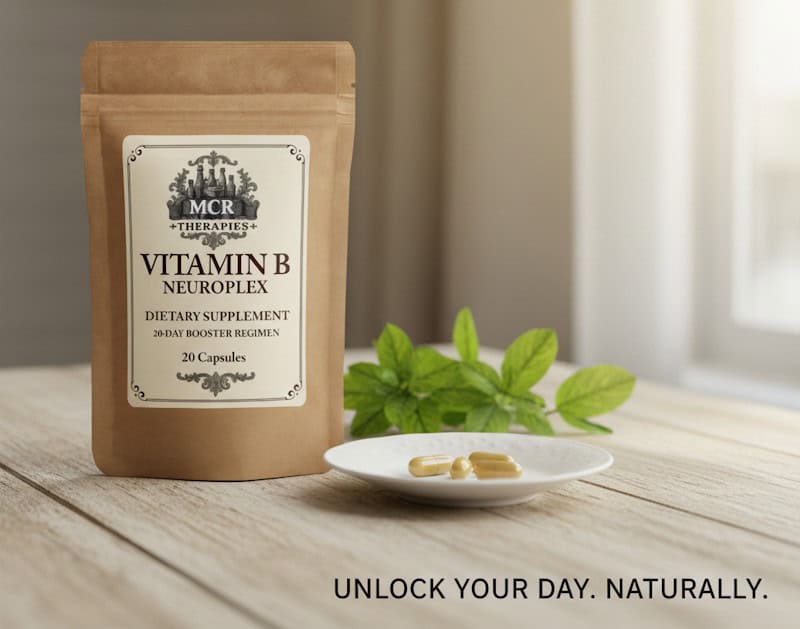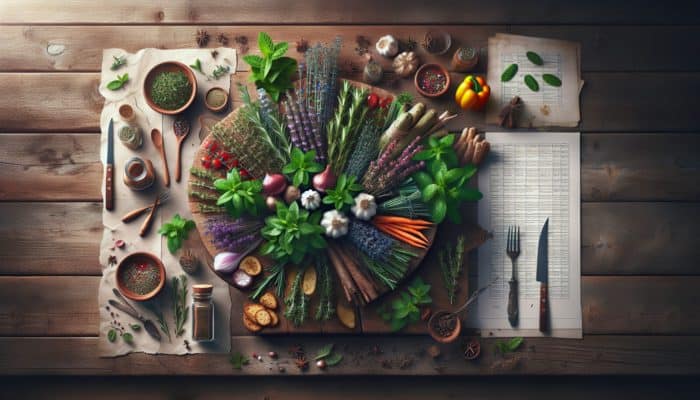Discover the Art of Fermenting Herbs for Enhanced Health in the UK
Unlock the Health Benefits of Fermented Herbs for Your Well-Being

How to Ferment Herbs for Health: Fermented herbs represent a remarkable addition to any dietary regimen, offering numerous health benefits that can significantly enhance your overall well-being. In the UK, the practice of fermentation not only bolsters personal health but also reconnects us with time-honoured traditions that have proven effective over centuries. The fermentation process converts raw herbs into powerful sources of probiotics, which are vital for maintaining gut health. Research indicates that these beneficial bacteria can facilitate digestion, reduce inflammation, and support the immune system. By incorporating fermented herbs into your diet, you can access a natural remedy that encourages better health, helping to prevent common ailments while supporting essential bodily functions.
Moreover, fermented herbs can significantly enhance your culinary experience by introducing distinctive flavours and scents. Imagine transforming ordinary mint leaves into a zesty, bubbly condiment that enhances your dishes. The fermentation process not only enriches the nutritional profile of these herbs, making them more digestible, but also improves the absorption of their essential nutrients. Including fermented herbs in your meals can elevate your nutrient intake while providing a delightful sensory experience.
The health benefits of fermented herbs extend far beyond basic digestion. The presence of lactic acid bacteria within these herbs contributes to a balanced microbiome, affecting various aspects of health and metabolism. Thus, incorporating fermented foods into your daily routine can enhance mental clarity, boost well-being, and promote a sense of overall well-being. Mastering the art of fermenting is not merely a culinary skill; it is a crucial step towards enhancing your vitality and well-being.
Explore the Most Popular Herbs for Fermentation in the UK
The UK is home to a rich variety of herbs that are ideal for fermentation, with popular choices including mint, basil, and rosemary. These herbs are not only easily accessible but also well-suited to the UK palate. For example, mint is a common feature in many UK gardens, adding a refreshing twist to fermented products. Whether you’re creating a zesty mint sauce or a revitalising herbal tonic, fermented mint can enhance both everyday dishes and beverages.
Basil stands out as another superb candidate for fermentation. Renowned for its aromatic qualities, fermented basil can add depth to a variety of sauces, dressings, and marinades. The fermentation process accentuates its flavour, resulting in a more complex and delightful taste. Rosemary, known for its strong character, also benefits significantly from the fermentation process. This herb introduces a fragrant, earthy note to culinary creations, and when fermented, it offers a unique flavour profile that enhances both savoury and sweet dishes.
In addition to these well-known herbs, consider exploring other varieties, such as dill and coriander, both of which are also well-suited for fermentation. Each herb presents its unique flavours and health benefits, encouraging experimentation and exploration of combinations that suit your taste preferences. The versatility of these herbs provides ample opportunity to customise your fermented concoctions, making the journey of learning how to ferment herbs for health both beneficial and enjoyable.
Essential Safety Guidelines for Fermenting Herbs
When embarking on your fermentation journey, ensuring safety is of utmost importance. Implementing proper hygiene practices is vital to prevent contamination and guarantee that your fermented creations are safe for consumption. Begin by thoroughly washing your hands and all equipment, including jars and utensils, before handling your herbs. This simple yet effective step can significantly diminish the risk of harmful bacteria jeopardising your hard work.
Understanding the fermentation environment is equally crucial. Fermentation thrives in an anaerobic environment, which necessitates minimising oxygen exposure. Utilising airlock jars can help maintain this condition, preventing oxygen ingress that could lead to spoilage. It is critical to monitor your fermentation closely, watching for any unusual odours or signs of mould. Should you encounter anything unusual, it is prudent to err on the side of caution and discard the batch.
Additionally, be mindful of the specific herbs you choose to ferment. Some herbs possess potent flavours or may contain compounds that could influence the fermentation process. Always conduct thorough research on the herbs you intend to ferment to verify their safety and suitability for this method. By adhering to these guidelines, you can relish the health benefits of fermented herbs while minimising potential risks. Embracing these cautious practices is essential to successfully mastering the art of fermenting herbs for health in a safe and rewarding manner.
Discover Traditional Fermentation Techniques in the UK

The UK boasts a rich heritage of fermentation, with traditional methods offering a treasure trove of knowledge for those keen on preserving herbs. One of the most established techniques is lacto-fermentation, which harnesses the power of lactic acid bacteria to ferment herbs. This technique not only preserves the herbs but also amplifies their flavour and nutritional value. Fermentation has been practised for centuries, ensuring that seasonal herbs can be enjoyed year-round.
Lacto-fermentation involves immersing herbs in a saline solution, allowing beneficial bacteria to thrive while inhibiting the growth of spoilage organisms. This method is particularly advantageous for herbs like parsley and dill, as it helps maintain their vibrant colours and robust flavours. The outcome is a tangy, probiotic-rich condiment that can significantly elevate your cooking.
Moreover, traditional UK practices often employ natural fermentation without the use of added starters. This approach relies on the naturally occurring bacteria present on the herbs or in the environment. It’s a method that fosters a deeper connection with the ingredients and underscores the sustainability of utilising what is readily available. By embracing these traditional methods, you can master the art of fermenting herbs for health, all while honouring the culinary heritage of British practices.
Understanding the Seasonal Availability of Herbs for Fermentation
Recognising the seasonal availability of herbs is essential for optimising your fermentation endeavours. The UK climate varies considerably throughout the year, influencing which herbs are accessible at different times. For instance, spring and summer are prime seasons for herbs like basil and mint, while autumn brings an abundance of sage and thyme. By aligning your fermentation projects with these seasonal cycles, you can ensure that you are utilising the freshest and most flavourful herbs.
Frequenting local farmers' markets or community gardens can provide access to fresh, in-season herbs. This practice not only supports local agriculture but also fosters connections within your community and the natural rhythms of the environment. In the winter months, consider utilising dried herbs or exploring varieties that thrive in cooler weather, such as rosemary and thyme, which can often be found in UK gardens despite the frost.
Timing your fermentation project is crucial, as herbs will yield their best flavours and aromas when they are at their peak. By learning to recognise the seasonal patterns and their corresponding herbs, you will enhance your ability to master the art of fermenting herbs for health, resulting in vibrant, delicious, and nutritious outcomes that showcase the best of what the UK has to offer.
Making Informed Choices on Herbs for Fermentation in the UK
Understanding Seasonal Availability for Optimal Choices

Choosing the right herbs for fermentation is closely linked to understanding their seasonal availability. In the UK, herbs such as sage and thyme particularly thrive during the spring and summer months. Sage, known for its robust flavour, is an excellent choice for fermentation, as it pairs wonderfully with a variety of dishes, from meats to vegetable preparations. Its peak availability occurs during the warmer months, making this the ideal time for harvesting and fermenting.
Thyme, another quintessentially British herb, flourishes under diverse conditions and is frequently found in gardens across the nation. While this hardy herb can be used year-round, fresh thyme reaches its zenith during late spring to early autumn. Fermenting thyme can enhance its aromatic qualities, making it a delightful addition to sauces, stews, and marinades.
For those interested in foraging, wild herbs such as nettles and dandelions are plentiful during spring, making them excellent candidates for fermentation. Nettles, which are rich in nutrients, can be fermented into a tangy, healthful addition to your meals. Recognising the seasons and the optimal times to harvest these herbs will not only enhance your culinary skills but also deepen your understanding of the natural world around you. Ultimately, this knowledge is essential for mastering the art of fermenting herbs for health benefits.
Finding Quality Herbs for Fermentation
Sourcing high-quality herbs is essential for successful fermentation. In the UK, local suppliers frequently offer fresh, organic options that are ideal for this purpose. Farmers' markets serve as a treasure trove for herb enthusiasts, showcasing a diverse range of herbs directly from local growers. Engaging with farmers can also provide valuable insights into the best practices for cultivating and maintaining herbs, enriching your understanding of these vital ingredients.
If you prefer a hands-on approach, consider cultivating your herbs. Many herbs are relatively easy to grow in small spaces, whether in a garden or on a windowsill. Growing your herbs not only guarantees freshness but also allows you to control the growing conditions, ensuring that no pesticides or harmful chemicals interfere with the fermentation process.
Quality is paramount in fermentation; using vibrant, unblemished herbs will yield superior results. Take the time to inspect your herbs for signs of wilting or decay before beginning the fermentation process. The freshness of your ingredients will have a direct impact on the quality of your final product, making it essential to invest in the best herbs available. This careful sourcing is a crucial component of successfully learning how to ferment herbs for health benefits.
Identifying Edible Wild Herbs for Fermentation
Foraging for wild herbs can be an exhilarating and rewarding experience, especially in the UK countryside, where a diverse range of edible herbs flourish. Among the most notable are nettles and dandelions, both often regarded as weeds yet brimming with nutrients. Nettles are rich in vitamins A and C, iron, and antioxidants, making them a powerhouse for health-conscious individuals. When prepared correctly, they can be transformed through fermentation into a delightful, tangy addition to soups and stews.
Dandelions, frequently overlooked, present another fantastic foraging opportunity. Every part of the dandelion plant is edible, from the leaves to the flowers. Fermenting dandelion leaves can yield a unique flavour profile that enhances salads and other dishes, while the flowers are perfect for crafting dandelion wine or infusing vinegar. However, it is essential to ensure that any wild herbs foraged are free from pesticides and other chemicals, highlighting the importance of foraging in organic environments.
Learning to identify these wild herbs not only enhances your culinary repertoire but also deepens your connection with nature. By embracing the practice of foraging, you enhance your understanding of local ecosystems and cultivate a deeper appreciation for the biodiversity that thrives in the UK. This awareness will enhance your ability to successfully incorporate wild herbs into your fermentation projects, enabling you to expand your skills in fermenting herbs for health benefits.
Preparing Herbs for the Fermentation Process
Thorough Cleaning and Sorting of Herbs
The cornerstone of successful fermentation begins with meticulous preparation, starting with the cleaning and sorting of your herbs. It is crucial to wash your herbs thoroughly under cold running water to eliminate any dirt, insects, or potential contaminants. This step is vital in guaranteeing a clean fermentation process and preventing spoilage. After washing, carefully sort through your herbs, discarding any wilted or damaged leaves. Fresh, vibrant herbs will significantly contribute to the flavour and quality of your fermented products.
Once cleaned, it is advisable to gently dry your herbs with a clean kitchen towel or salad spinner. Excess moisture can adversely affect the process, as it is unsuitable for beneficial bacteria in an unsuitable environment. Ensuring that your herbs are adequately dried will promote successful fermentation, allowing the flavours to develop fully without the risk of spoilage.
Moreover, it’s important to consider the specific types of herbs you are preparing. Different herbs may require distinct handling techniques. For instance, delicate herbs like basil or parsley should be treated gently to avoid bruising, while sturdier herbs like rosemary can endure more vigorous treatment. By understanding the individual needs of each herb, you enhance your ability to successfully learn how to ferment herbs for health while ensuring the best outcomes in your culinary endeavours.
Chopping and Bruising Techniques for Enhanced Fermentation
Chopping and bruising herbs are indispensable steps in preparing them for fermentation. This process helps release the aromatic oils and flavours that are encapsulated within the leaves, thereby enhancing the overall taste of the final product. For example, bruising mint leaves can release their invigorating oils, making them even more pronounced during the fermentation process.
When chopping herbs, strive for uniform pieces to ensure even fermentation. However, be cautious with the size; larger chunks may require longer fermentation times, while smaller pieces can lead to over-fermentation if not monitored closely. The objective is to strike a balance that optimises flavour extraction while allowing beneficial bacteria to flourish throughout the fermentation process.
Experimenting with various chopping techniques can also yield unique flavour profiles. For instance, coarsely chopped herbs may create a more robust taste, while finely chopped herbs can provide a subtle infusion. By learning to manipulate the physical structure of your herbs through chopping and bruising, you gain greater control over the fermentation process, ultimately enhancing your abilities in how to ferment herbs for health.
Blending Herbs for Unique Flavour Combinations
Combining different herbs can create exciting and distinctive flavour profiles, elevating your fermented products to new culinary heights. The UK offers a diverse array of herbs that can beautifully complement one another. For instance, blending mint with basil can create a refreshing twist that works wonders in salads or as a topping for grilled meats. Similarly, mixing rosemary with thyme can add depth to your home-fermented pickles or sauces.
When creating your blends, consider the flavours and aromas of each herb. Balancing the intensity of flavours ensures that no single herb overshadows the others. It is often beneficial to begin with a base herb and then layer in additional herbs to achieve a harmonious taste. For example, using sage as a base can be enriched with hints of thyme or lemon balm for a fresher profile.
Experimentation is vital; don’t hesitate to try combinations that intrigue you. Keep a journal of your blends and their outcomes, as this will allow you to refine your techniques over time. By blending herbs thoughtfully, you can master the art of fermenting herbs for health, crafting a variety of flavours that cater to your culinary preferences.
Accurate Weighing and Measuring for Consistency
Accurate weighing and measuring of herbs are crucial components of a successful fermentation process. Different herbs possess varying moisture content and density, meaning that relying solely on volume measurements can lead to inconsistencies. Investing in a kitchen scale can significantly enhance your results by ensuring that you are using the correct proportions of herbs and salt, which is vital for achieving the desired taste and safety of your fermented products.
As a general guideline, a salt concentration of approximately 2-3% is recommended for herb fermentation. This level fosters an environment conducive to the growth of beneficial bacteria while inhibiting the growth of harmful pathogens. Weigh your herbs and calculate the required amount of salt accordingly, ensuring a precise balance that promotes optimal fermentation.
Additionally, maintaining meticulous records of your measurements will help you replicate successful batches in the future. By understanding the significance of weighing and measuring, you equip yourself with the knowledge necessary to master the art of fermenting herbs for health, resulting in consistent, high-quality outcomes in your fermentation projects.
Fermentation Techniques to Master in the UK
Embracing Traditional Fermentation Methods
Utilising traditional fermentation methods can significantly enhance the flavour and nutritional profile of your herbs. In the UK, lacto-fermentation is a favoured technique that utilises lactic acid bacteria to preserve herbs while intensifying their flavours. This method is not only effective for preserving herbs but also for cultivating beneficial bacteria that promote gut health.
The lacto-fermentation process begins by preparing a saline solution, typically a brine, in which the herbs are submerged. The salt encourages the growth of lactica while creating an inhospitable environment for harmful bacteria. This method works exceptionally well for herbs like dill and parsley, transforming them into flavour-rich condiments that elevate various culinary creations.
In addition to lacto-fermentation, exploring alternative traditional methods such as wild fermentation can yield exciting results. Wild fermentation relies on the naturally occurring bacteria present on the herbs and in the environment, creating unique flavour profiles that reflect the local terroir. This technique not only connects you to the land but also allows for creativity and spontaneity in your fermentation projects. By embracing these traditional methods, you can deepen your understanding of how to ferment herbs for health while honouring the culinary heritage of the UK.
Utilising Modern Fermentation Tools for Success
Modern fermentation tools can significantly streamline the fermentation process, making it more accessible for both beginners and experienced fermenters. In the UK, various products are readily available to assist in your efforts, such as fermentation jars equipped with airlocks. These specialised jars provide a controlled environment for fermentation, allowing gases to escape while preventing oxygen from entering, thereby reducing the risk of spoilage.
Another valuable tool is a fermentation weight, which helps to keep herbs submerged in the brine, ensuring they remain anaerobic throughout the fermentation process. This is particularly crucial when working with delicate herbs that may float to the surface of the mixture. By employing these modern tools, you can enhance your fermentation success and achieve a more consistent outcome.
Moreover, advancements in technology have made temperature control increasingly manageable. Some fermentation jars come with built-in temperature sensors, enabling you to monitor the fermentation environment closely. Optimising temperature is vital; the ideal range for herb fermentation typically falls between 18 °C and 22 °C. By utilising these tools, you can master the art of fermenting herbs for health, ensuring your fermentation projects yield delicious and nutritious results.
Mastering Temperature Control for Optimal Fermentation
Maintaining an optimal temperature during fermentation is critical for achieving the best results. The UK’s climate can vary significantly, affecting the fermentation process. During warmer months, fermentation may occur more rapidly, while cooler temperatures can significantly slow the process. Understanding how to adjust your fermentation environment is key to successful herb fermentation.
A consistent temperature range of 18 to 22°C is generally ideal for herb fermentation. Within this range, beneficial bacteria thrive while harmful pathogens are inhibited. To achieve these conditions, consider placing your fermentation jars in a warm, dark cupboard or using a fermentation chamber if you are serious about your craft.
Additionally, closely monitoring your fermentation is beneficial, as fluctuations in temperature can impact the flavour and texture of the final product. If you notice that fermentation is progressing too slowly, consider relocating your jars to a warmer area. Conversely, if fermentation seems too rapid, find a cooler location. By mastering temperature control, you will enhance your ability to learn how to ferment herbs for health, resulting in deliciously fermented herbs that promote well-being.
Storing and Preserving Your Fermented Herbs
Optimal Storage Conditions for Fermented Herbs
Proper storage conditions are essential for maintaining the quality of your fermented herbs. In the UK, ideal storage involves keeping your jars in a cool, dark place, away from direct sunlight. Excess light can degrade the quality of your fermented products, leading to a decline in flavour and nutrients. A pantry or cupboard is often the perfect location for this purpose, provided it remains cool.
Temperature stability is also paramount; fluctuations can compromise the quality of your fermented herbs. Ideally, your storage area should maintain a consistent temperature, preferably at cool room temperature or slightly below this level. This will help preserve the vibrant flavours and nutritional benefits of your fermented herbs.
Once fermentation is complete, transfer your jars to the refrigerator, which halts the fermentation process and extends the shelf life of your herbs. When stored properly, fermented herbs can last for several months, allowing you to enjoy the fruits of your labour long after the initial fermentation. By understanding the best storage techniques, you can master the art of fermenting herbs for optimal health, ensuring your creations remain delicious and nutritious for as long as possible.
Choosing the Right Packaging for Fermented Herbs
Selecting suitable packaging for storing your fermented herbs is crucial for ensuring their longevity and quality. In the UK, glass jars are a popular choice as they provide an airtight seal, protecting the contents from exposure to air and light. Mason jars or specialised fermentation jars with airlocks are particularly effective in maintaining an ideal anaerobic environment, which is essential for preserving the integrity of your fermented herbs.
When selecting jars, ensure they are clean and sterilised before use. This step is vital in preventing unwanted bacteria from compromising your fermented creations. It is advisable to choose jars with wide mouths, as they facilitate easier packing of the herbs and allow for straightforward removal when necessary.
Additionally, consider the size of the jars based on your intended usage. Smaller jars are ideal for single servings, while larger jars are better suited for bulk storage. Proper packaging not only preserves the quality of your fermented herbs but also allows for convenient access and portioning, making it simpler to incorporate them into your meals. By mastering packaging options, you enhance your ability to learn how to ferment herbs for health while ensuring a delightful culinary experience.
Understanding Shelf Life and Signs of Spoilage
Understanding the shelf life of fermented herbs is crucial for ensuring the safe consumption of these products. In the UK, properly fermented herbs can typically last for several months when stored correctly in the refrigerator. However, it is essential to monitor your creations for any signs of spoilage.
Common indicators of spoilage include off-smells, unusual textures, or the presence of mould. If you notice any of these signs, it is advisable to discard the batch to avoid potential health risks. Proper fermentation should yield a tangy, pleasantly aromatic product that enhances the flavours of your meals.
To extend the shelf life of your fermented herbs, consider using smaller jars for storage. This strategy allows you to open only what you need while keeping the remaining herbs sealed and protected. Understanding the typical shelf life and recognising spoilage signs will empower you to safely enjoy the fruits of your fermentation efforts, reinforcing your mastery of how to ferment herbs for health.
Importance of Labelling and Dating Your Fermented Herbs
Labelling and dating your fermented herbs is an essential practice that ensures freshness and safe consumption. In the UK, it is advisable to use waterproof labels or a permanent marker to indicate the fermentation date on each jar. This practice serves as a visual reminder of the product's storage duration, helping to track its shelf life.
In addition to the date, consider noting the type of herbs used and any specific flavour profiles or intended uses. This information can be invaluable when planning meals, allowing you to quickly identify which jar to reach for when seeking culinary inspiration.
By maintaining clear labels on your jars, you not only simplify your culinary processes but also promote food safety. This attention to detail is a vital component of successfully learning how to ferment herbs for health, ensuring that you always enjoy your fermented creations at their peak freshness.
Freezing Fermented Herbs for Extended Shelf Life
Freezing fermented herbs is an effective method for extending their shelf life while preserving their flavour and nutritional benefits. In the UK, consider transferring your fermented herbs into freezer-safe containers or bags, ensuring that you remove as much air as possible before sealing. This practice reduces the risk of freezer burn, which can compromise the quality of your herbs.
When freezing, it’s wise to portion your herbs into smaller quantities, as this facilitates easy access during cooking. By freezing in ice cube trays, you can create convenient, ready-to-use herb cubes that can be directly added to soups, stews, or sauces. This technique not only allows you to relish your fermented herbs long after their initial creation but also adds a layer of convenience to your culinary repertoire.
It is essential to note that while freezing preserves the flavour and health benefits of fermented herbs, the texture may change slightly upon thawing. However, this should not detract from their usability in cooking. By incorporating freezing into your preservation techniques, you can expertly learn how to ferment herbs for health, allowing you to savour the benefits of your hard work throughout the year.
Integrating Fermented Herbs into Your UK Diet
Maximise Culinary Uses of Fermented Herbs
Incorporating fermented herbs into your diet can revolutionise traditional UK dishes, enriching them with unique flavours and health benefits. These herbs can enhance everything from classic stews to modern salads, adding depth and tanginess that elevates the overall dining experience. For instance, incorporating fermented mint into a lamb dish can impart a delightful brightness, while fermented dill can add a refreshing touch to fish recipes.
Beyond main courses, consider incorporating fermented herbs into dressings and sauces for added flavour. A tangy fermented herb vinaigrette can transform a simple salad into a culinary masterpiece. Similarly, adding fermented herbs to dips, such as yoghurt or hummus, can create a flavour explosion that impresses your guests and family alike. The versatility of fermented herbs makes them an invaluable addition to any kitchen, encouraging creativity and experimentation in your cooking.
Additionally, fermented herbs can complement traditional British fare, such as pies and roasts, by providing a surprising twist to familiar recipes. As the trend towards plant-based diets grows, incorporating fermented herbs offers a way to introduce complex flavours without sacrificing nutrition. Thus, the culinary possibilities of fermented herbs are limitless, underscoring the importance of mastering the art of fermenting herbs for health for any aspiring home cook.
Enhancing Health Supplements with Fermented Herbs
Fermented herbs can seamlessly be integrated into health supplements, providing a natural boost to your wellness routine. In the UK, many individuals are gravitating towards herbal teas and tinctures that utilise the benefits of fermented herbs. For instance, a fermented mint tea can offer soothing properties for the digestive system. In contrast, a tincture made with fermented nettles may deliver a variety of vitamins and minerals that support overall health.
When crafting herbal supplements, consider extraction methods that optimise the bioavailability of the herbs. For example, steeping fermented herbs in hot water can release their beneficial compounds, allowing you to create potent tonics that address specific health needs. Furthermore, many herbalists recommend blending fermented herbs with honey or lemon to enhance their flavour and health benefits.
Incorporating fermented herbs into your wellness regimen offers a holistic approach to health, marrying culinary enjoyment with nutrition. This practice not only supports digestive health but also fosters a balanced microbiome, reinforcing the connection between diet and overall well-being. By exploring the realm of health supplements, you deepen your understanding of how to ferment herbs for health, ultimately enhancing your lifestyle and vitality.
Discovering Creative Recipes Featuring Fermented Herbs
Exploring creative recipes that highlight the use of fermented herbs in UK cuisine can unveil a plethora of culinary possibilities. Consider crafting a fermented herb pesto by blending basil, parsley, and fermented garlic, resulting in a rich and tangy sauce that pairs exceptionally well with pasta dishes, sandwiches, or as a dip for vegetables.
Another innovative recipe to try is fermented herb-infused oils. By combining olive oil with your favourite fermented herbs, you can create a delicious finishing oil that adds an explosion of flavour to salads, grilled meats, or roasted vegetables. The infusion process allows the oil to absorb the unique characteristics of the herbs, resulting in a versatile ingredient that can elevate any dish.
Additionally, don’t overlook desserts. Fermented herbs like lavender or chamomile can be utilised in sweet applications, such as infused syrups or ice creams, providing a delightful twist to traditional recipes. The versatility of fermented herbs enables experimentation and creativity, reinforcing the practical knowledge of how to ferment herbs for health benefits.
Utilising Community Resources and Support for Fermentation in the UK
Exploring Local Libraries and Community Centres
Local libraries and community centres in the UK can serve as invaluable resources for anyone eager to learn more about fermentation. These institutions often host workshops, classes, and events centred around traditional food preservation methods, including fermentation. Attending such events can provide hands-on experience and connect you with like-minded individuals who share your passion for healthy eating.
Additionally, these venues often have extensive collections of books and online resources that cover fermentation techniques, health benefits, and innovative culinary applications for fermented herbs. By accessing these resources, you can deepen your knowledge and skills in fermenting herbs for health while also fostering a sense of community and support among fellow enthusiasts.
Furthermore, local community gardens often offer opportunities to engage in foraging and growing your herbs. By participating in these initiatives, you can enhance your understanding of the seasonal availability of herbs while learning sustainable practices that benefit both your health and the environment. Embracing these community resources is a fulfilling way to master the art of fermentation while creating connections with others who share your interests.
Addressing Common FAQs About Fermenting Herbs
What are the key health benefits associated with fermenting herbs?
Fermented herbs enhance digestion, boost immunity, and provide probiotics, making them a powerful addition to any diet for improved overall health.
Which herbs are most suitable for fermentation in the UK?
Popular herbs for fermentation in the UK include mint, basil, rosemary, dill, and thyme, each offering distinct flavours and health benefits.
How can I ensure the safe fermentation of herbs?
To ensure safe fermentation, practice good hygiene by washing your hands and equipment, using clean jars, and monitoring for signs of spoilage throughout the fermentation process.
What is the process of lacto-fermentation?
Lacto-fermentation is a traditional method that utilises lactic acid bacteria to ferment herbs, preserving their flavour and nutritional value while promoting gut health.
How long can I expect fermented herbs to last?
When stored properly in the refrigerator, fermented herbs can last for several months. It's crucial to monitor them for signs of spoilage regularly.
Is it possible to freeze fermented herbs?
Yes, freezing fermented herbs is a great way to prolong their shelf life while preserving flavour and nutritional benefits. Use freezer-safe containers to store them. How can I incorporate fermented herbs into my cooking?
Fermented herbs can enhance salads, sauces, stews, and dips, providing unique flavours and health benefits. Consider experimenting with different dishes to find your favourites.
Where can I find fresh herbs suitable for fermentation?
You can source fresh herbs at local farmers' markets, gardening centres, or even grow your own at home to ensure optimal quality for fermentation.
What are the signs of spoilage in fermented herbs?
Indicators of spoilage include off-smells, unusual textures, and visible mould. If you notice any of these signs, it's best to discard the batch.
Can I create health supplements using fermented herbs?
Absolutely! Fermented herbs can be used in teas and tinctures, providing natural health supplements that offer various benefits, such as improved digestion and immune support.

























1 Comment
I really appreciate how you highlighted the connection between fermenting herbs and our cultural traditions. It’s fascinating to think about how practices that were once commonplace are making a comeback in our modern diets, especially as we seek to improve gut health. I recently started incorporating fermented dill into my meals, and the flavor it brings is just delightful! Plus, knowing that I’m benefiting my digestion and immune system is such a bonus.